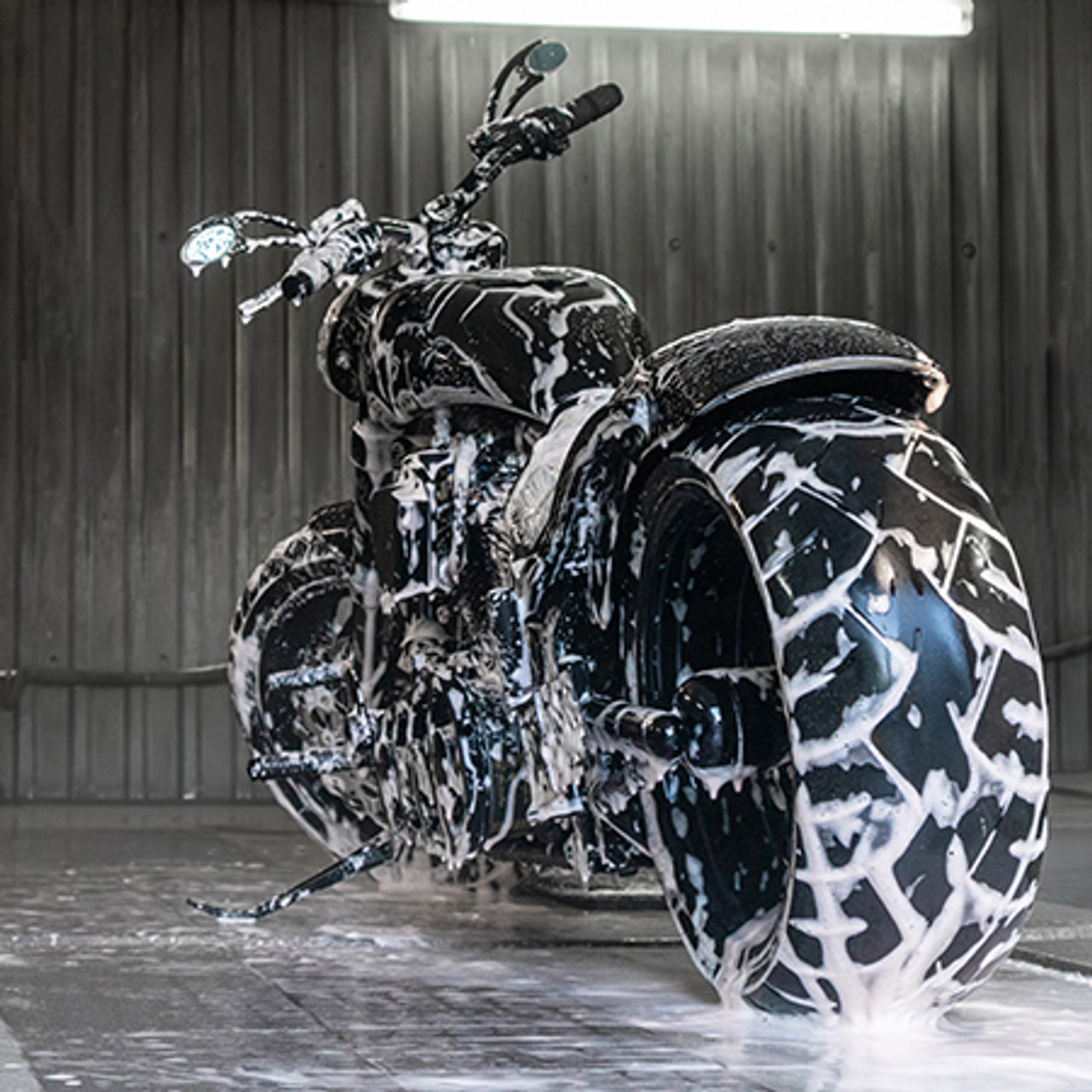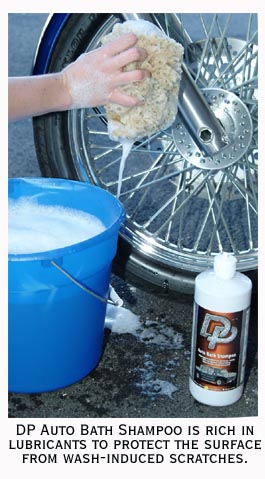
Facts on Washing & Drying Your Motorcycle
Washing
Most motorcycle enthusiasts understand the importance of proper surface maintenance. The reasons we wash our bikes are to improve appearance and protect surfaces from the hazards of road grime, bug residues, polluting contaminants, as well as, tar and tree sap deposits. That said, washing a motorcycle is somewhat different than washing a car.
Always remove all detatchables (bags, boxes, etc.) prior to washing the motorcycle. Always work on a cool bike out of direct sunlight. Metal areas especially are prone to spotting if soap dries on them.

1. First step; the wheels. Get them clean first. We'd recommend any of the great wheel cleaners on our site. DP Cleanse-All Wheel Cleaner or S100 Wheel Cleaner are among the best. Always use wheel cleaners on cool wheels to avoid spotting.
The very best tool for cleaning motorcycle wheels is the EZ Detail Brush. This flexible, nonabrasive brush flattens to reach into crevices and between spokes, but it always go back to its original shape. Just dip it in warm water to fluff the bristles up. The nylon Nylex bristles can be used with any wheel cleaner. The flexible stem can be bent to reach around curved or concave areas with ease. The EZ Detail Brush is a must-have for all motorcycle owners!
After cleaning each wheel, rinse well. The Fire Hose Nozzle has an adjustable stream and its encased in rubber to guard against scratching the motorcycle.
2. Now clean the rest of the bike. Do not use dish soap! Household cleaners are far too alkaline to use on automotive or motorcycle finishes. Do use a high quality automotive shampoo such as DP Auto Wash – by far one of the best values to use on your bike or your car. It'll work great at loosening and removing hardened road grime, and rinses clean away – leaving no hazy films – just a clean shine.
Use a plush-cleaning tool such as our Natural Sea Sponge or Sheepskin Wash Mitt to luxuriously remove contaminants. These are important cleaning aides – they work to pull any abrasives away from the surface, which prevents scratches. A conventional sponge holds such debris at its surface and drags it across the paint. If you doubt this, just use the sponge in your kitchen sink to wipe crumbs off your counter – then turn it over and observe. The dirt is at the surface – making household sponges the enemy of painted and plastic surfaces everywhere!
For concave areas between pipes, you can again use the EZ Detail Brush. It goes anywhere! Just be sure you've rinsed it very well after cleaning the wheels to prevent cross-contamination.
3. Rinse the sections you've cleaned as you go. Then finish with a thorough final rinse to remove residual shampoo and contaminants.
Drying
Once clean, dry the motorcycle immediately.
Drying the bike quickly helps prevent water spots from settling on the paint and chrome. It also whisks away minor surface contaminants missed during the rinsing process. You have several options to facilitate fast drying.
Vacuum blowers are a great alternative to hand drying. Two of our favorite are Metro Vac N'Blo®: this portable vacuum has the added feature of a powerful blower. Packed with attachments, the 4.0 peak horsepower unit comes complete with a shoulder strap for easy handling. Great for detailing all your vehicles!
For added power, the Metro Motorcycle Air Force Blaster is designed specifically to serve the needs of motorcycle enthusiasts – this versatile machine really packs a punch! The peak horsepower is still 4.0, but the Air Force Blaster jettisons air at an impressive 29,000 ft./min. Either choice will dry your bike substantially faster than typical hand drying. The Air Force Commander is a smaller version of the Blaster. It still puts out an impressive amount of air, plenty to get your motorcycle dry in a matter of minutes.
If you're going to hand dry; use the best possible tools. The world has gone hi-tech, and so have our towels. Synthetic microfiber outperforms cotton clothes and chamois, while pulling residual contaminants away from the surface and buffing out fresh water spots. Two of the best microfiber towels we have used are by Cobra. The Cobra Guzzler Waffle Weave Towel measures 16x24. The exclusive waffle-weave of the fibers was developed specifically to improve liquid absorption. The thirsty 80/20-polyester/polyamide blend is lint free and makes drying a snap.
The Cobra Supreme Guzzler Waffle Weave Towel measures a whopping 20x40 – giving you over 5 feet of drying power. More than enough to dry an entire car or motorcycle! Both towels are irritant free and 100% hypoallergenic. If you're not going to use a blower – these are the next best thing. You won't believe how absorbent they are!
Run the motorcycle for a few minutes after your first drying pass to dry engine components and shake off any left over water. It's a good idea to do a final drying pass after you turn off the ignition – just to make sure she's all dry.
Detailer's Tip: As you're giving your bike a final wipe-down, spray on a coat of gloss. Mist the paint and pipes with Pinnacle Crystal Mist to enhance the shine of existing wax and discourage water spots.
If your motorcycle does not have any wax on it currently, choose a carnauba or synthetic wax to seal the painted portions. Choose from DP Max Wax Carnauba Paste Wax, S100 Carnauba Paste Wax, Pinnacle Liquid Souveran, or Wolfgang Deep Gloss Spritz Sealant. Any of these products will produce a deep gloss and give your motorcycle excellent protection against the elements. For more options, visit the Motorcycle Wax & Quick Detail Spray section.
